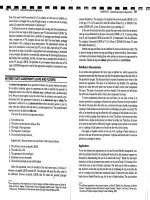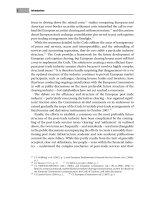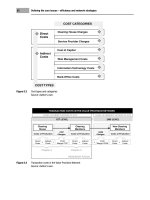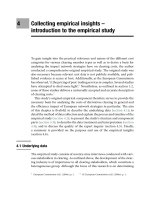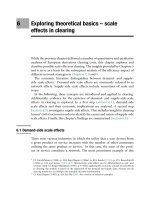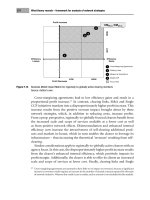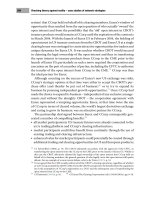Trend Forecasting with Intermarket Analysis Predicting Global Markets with Technical Analysis Trade Secrets Marketplace Books_1 docx
Bạn đang xem bản rút gọn của tài liệu. Xem và tải ngay bản đầy đủ của tài liệu tại đây (112.19 KB, 14 trang )
trade secrets
Xiv
As with those articles in Commodities and Futures nearly twenty-five
years ago, this book presents sound, practical information about forex
trading, focusing on the benefit of analytic trading software that can
make highly accurate short-term forecasts of the market direction of
this exciting and potentially highly lucrative trading arena.
DARRELL R. JOBMAN
____________________________
Darrell Jobman is an acknowledged authority on the financial markets and has been writing
about them for over 35 years. After spending nearly 20 years as editor of Futures Magazine
Mr. Jobman is now Editor-in-Chief for www.TradingEducation.com. Mr. Jobman has authored
and/or edited six books including The Handbook of Technical Analysis as well as trading
materials for both the Chicago Mercantile Exchange and the Chicago Board of Trade.
PREFACE
PreFaCe
Xvii
ForeX trading using interMarket anaLysis
THis Book exPlores the application of intermarket analy-
sis to the foreign exchange market, the world’s largest and most
widely traded financial market. Intermarket analysis helps traders
identify and anticipate changes in trend direction and prices due
to influences of other related markets as financial markets have
become interconnected and interdependent in today’s global economy.
These markets include forex futures and options as well as major cash
forex pairs, which are affected not only by other currencies but by
related markets such the S&P 500 Index, gold, crude oil, and interest
rates. As the world economy of the twenty-first century continues to
grow and as new advances in information technologies continue to be
introduced, financial markets will become even more globalized and
sophisticated than they are today, increasing the central role that the
forex markets play in the global economy.
Since its introduction in the 1980s, intermarket analysis has become
a critical facet of the overall field of technical analysis because it
empowers individual traders to make more effective trading decisions
based upon the linkages between related financial markets. By incor-
porating intermarket analysis into trading plans and strategies instead
of limiting the scope of analysis to each individual market, traders can
make these relationships and interconnections between markets work
for instead of against them.
Forex markets are especially good candidates for intermarket analysis
because of the key role of the U. S. dollar in most major currency
pairs while other currencies tend to move in concert against the dollar.
What influences one currency often influences many other currencies,
usually not in lockstep but to a greater or lesser degree, depending on
the circumstance. Knowing what is occurring in various currencies
and other related markets can provide traders with both a broader
perspective and greater insight into forex market dynamics. It can
trade secrets
Xviii
thereby provide an early warning of impending changes in trend direc-
tion in the target market. This allows traders to make more effective
and decisive trading decisions than would be possible by relying on
traditional single-market technical analysis indicators that too often
lag the market.
This book is addressed primarily to traders and investors who use per-
sonal computers and the Internet to analyze forex markets and make
their own trading decisions. The book also offers insights into how
day traders and position traders in both the cash and futures markets
can improve their trading performance and achieve a serious competi-
tive advantage in today’s globally interdependent financial markets. It
will interest both experienced traders and newcomers to forex markets
who are inclined toward technical analysis and recognize the potential
financial benefits of incorporating intermarket analysis into their trad-
ing strategies.
Louis B. Mendelsohn
INTRO
inTrodUCTion
XXi
ForeX trading using interMarket anaLysis
i reCoUnTed HoW i goT inVolVed in commodity futures trading
and computerized technical analysis in my 2000 book, Trend Forecasting
with Technical Analysis: Unleashing the Hidden Power of Intermarket
Analysis to Beat the Market. However, I believe that it is worth repeat-
ing the highlights here because they address the convergence of the
development of futures trading and trading software technology during
the 1980s and 1990s that is now applied in today’s hot forex markets.
I traded stocks and options for nearly a decade, using various technical
analysis methods before I began day trading and position trading com-
modities in the late 1970s while employed as a hospital administrator
for Humana, one of the largest for-profit hospital management compa-
nies in the United States at that time. A physician friend who traded
gold futures provided the encouragement that moved me from equities
into this new trading area. This was during the inflationary period when
gold prices were building to a peak above $800 an ounce, so there was
incredible market excitement surrounding commodities trading.
At first I subscribed to weekly chart services, which had to be updated
by hand during the week and required a very sharp pencil to draw
my support and resistance lines, which in turn determined where I
placed my stops. It was very annoying to anticipate the trend direc-
tion correctly, only to miss out on a big move after being stopped out
prematurely at a loss due to an ill-placed stop.
With only a handheld calculator available to compute numbers in the
years before microcomputers, I learned the underlying theories and
mathematical equations for numerous technical indicators, such as
moving averages, and devised mathematical shortcuts to expedite my
daily calculations.
I was quite excited when I brought home my first personal computer
in the late 1970s. Soon I was teaching myself programming and writ-
ing simple software programs to automate many of these calculations.
trade secrets
XXii
I quickly realized that the marriage of technical analysis with micro-
computers would revolutionize financial market analysis and trad-
ing. Although I had been hooked on financial markets and technical
analysis for nearly a decade by then, it was the prospect of applying
computing technology to technical analysis that crystallized the intel-
lectual passion that I had long sought.
In 1979 at the age of 31 and intent on pursuing this goal, I started a
trading software company that was the predecessor to my current com-
pany, Market Technologies, LLC. A year later, with my wife Illyce’s
support and, more importantly, with her income, I left Humana to trade
commodities full-time while continuing to develop trading software. My
goal was to design technical analysis software that would do more than
just speed up the analysis calculations that I had been doing by hand
each evening with a calculator. I wanted to test and compare various
trading strategies that I had created to identify the best ones and fore-
cast the trend directions of the commodities markets that I traded.
Working alone and at a feverish pace, I spent day and night for the next
few years focused intently on my daily trading activities, researching
more about the commodities markets, studying books and articles on
technical analysis, examining every one of my winning and losing
trades for patterns to incorporate into my trading strategies, and devel-
oping trading software for the microcomputers that were just becoming
fashionable among commodities traders.
In 1983, after three years of full-time research and development in
which I was basically operating as a one-man think tank, I released
ProfitTaker Futures Trading software, which offered both automated
strategy back-testing capabilities and optimization. It was hot! It
even did back-testing on actual commodity contracts with a built-in
“rollover” function that moved from an expiring contract into the next
actively traded contract. This same year, I authored a series of articles
XXiii
ForeX trading using interMarket anaLysis
on technical analysis software for Commodities magazine (now known
as Futures) in which I introduced the concept of strategy back-testing
and optimization for microcomputers and outlined the impact that this
innovation would have on technical analysis and trading.
I was encouraged in those early years by several prominent techni-
cians and traders. Foremost among them was Darrell Jobman at
Commodities magazine. Had he not seen the potential of applying
computer technology and trading software to the markets when this
new technology was in its infancy and had he not supported these
efforts by publishing articles on the subject in his magazine, there is
no telling what route the application of computer software technology
to technical analysis might have taken.
For the next few years, I continued my software development efforts
with ProfitTaker, wrote many more articles, collaborated on books on
trading, and spoke at trading conferences at which I warned about the
dangers of curve-fitting and over-optimization. Now that strategy back-
testing is an integral part of today’s single-market technical analysis
software, I actually find it somewhat amusing (whereas as recently as
the late 1990s I often found it annoying) when I hear new traders, who
are just learning the ABCs of technical analysis, say that strategy test-
ing has always been in trading software—as if airplanes have always
taken off and landed. Little do they realize how much effort it took to
implement rollover back-testing on commodity contracts on an Apple
II+ computer with just two floppy disk drives.
By the mid-1980s, through my observations of changes in how the
markets interact, it had become apparent that the prevailing single-
market approach to trading software was already becoming obsolete.
I concluded that technical analysis that looked internally at only
one market at a time, such as ProfitTaker did, would no longer be
sufficient, even with its strategy testing and optimization features.
trade secrets
XXiv
Changes that were starting to occur in the global financial markets
due to advances in both computing and telecommunications technolo-
gies, coupled with the emerging “global economy,” made multimarket
analysis absolutely necessary.
I realized that the globalization of the world’s financial markets would
mean that the scope of technical analysis and its application through
the use of trading software to the financial markets would need to
change drastically. As a result, I embarked on my next maniacal mis-
sion, which would result in the development of intermarket analysis
software.
In that pursuit, the scope of technical analysis had to expand to include
not just a single-market analysis approach, where I had focused my
attention previously, but also an analysis of how related markets actu-
ally affect each other and, more importantly, how this information can
be applied by traders to their advantage. My goal was to examine the
linkages between related global financial markets so that they could be
quantified and used to forecast market trends and make more effective
and timely trading decisions.
In 1986 I developed my second trading software program, which
focused on these market interdependencies. The program, simply
named “Trader,” used a spreadsheet format to correlate the likely trend
direction of a target market with those of related markets, as well as
with expectations regarding fundamental economic indicators affecting
the target market. This trading software program, albeit quite primi-
tive by today’s standards, was the first commercial program available to
traders in the financial industry to implement intermarket analysis.
When the stock market crashed in October 1987, my convictions about
the interdependencies of the world’s equities, futures, and derivatives
markets were starkly affirmed. By then, I was sure that technical anal-
ysis would have to broaden its scope to include intermarket analysis,
XXv
ForeX trading using interMarket anaLysis
as the forces that would bring about the globalization of the financial
markets continued to gain strength.
Despite my early efforts at developing intermarket analysis software,
I was not satisfied with the underlying mathematical approach that I
had used to correlate intermarket data in the Trader program and felt
compelled to continue my quest for a more robust mathematical tool.
In the late 1980s fortuitously I began working with a mathematical tool
known as neural networks, which is a form of “artificial intelligence.”
I remembered this vaguely from academic material I reviewed while
an undergraduate at Carnegie Mellon University in Pittsburgh in the
late 1960s. A professor there, Herbert A. Simon, was an early pioneer
in the field of artificial intelligence and its application to decision-
making under conditions of uncertainty. In neural networks I found
the right tool for my job! Neural networks had the ability to quantify
the intermarket relationships and hidden patterns between related
markets that were increasingly responsible for price movements in the
global financial markets of the late 1980s.
In 1991 after considerable research in applying neural networks to
intermarket data, I introduced my third and latest trading software pro-
gram, VantagePoint Intermarket Analysis Software. I chose that name
because I felt that intermarket analysis gives traders a different van-
tage point on the markets than is possible looking at just one market
at a time. VantagePoint uses neural networks to analyze price, volume,
and open interest data on a specific target market and between that
market and various other related markets. The software then makes
short-term forecasts of the trend direction and high and low prices of
the target market.
At this same time, other technicians, working independently, began
to explore intermarket relationships, primarily from an intuitive and
descriptive standpoint rather than the quantitative approach that I had
taken. One of these analysts, John Murphy, who at the time was the
trade secrets
XXvi
technical analyst for CNBC, lent further credibility among traders to
the newly emerging field of intermarket analysis.
Since the late 1980s, I have continued to refine my trading software
based upon neural networks applied to intermarket analysis and have
succeeded at creating effective trend-forecasting trading strategies
built around forecasted moving averages. VantagePoint, which at first
only made forecasts for thirty-year Treasury bonds in 1991 when it
was first released, now tracks nearly seventy different global markets,
including stock indices, exchange-traded funds, interest rates, ener-
gies, agricultural markets, softs, and, of course, foreign exchange spot
and futures markets.
The focus of this book is on how to use intermarket analysis to forecast
moving averages, making them a leading, rather than a lagging, techni-
cal indicator for the dynamic forex markets.
FOREX
Forex Trading Using
inTermarkeT analysis

